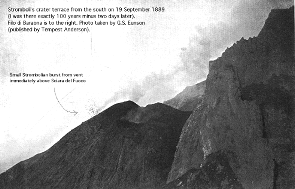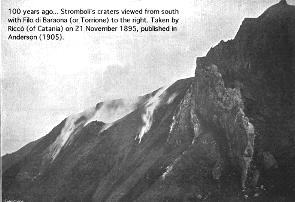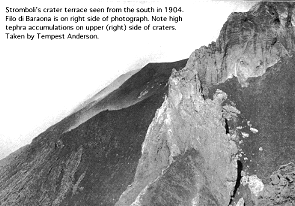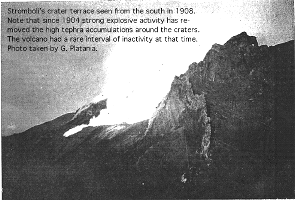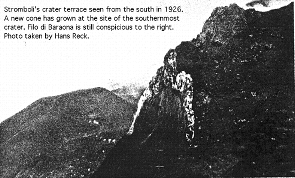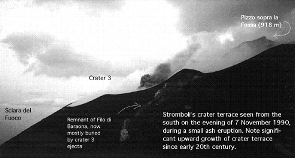| Stromboli
home page |
||
| Geography | Geological Evolution | Eruptive history |
| Volcanic Hazards | References | Web sites |
Stromboli before 1930
The earliest records of activity at Stromboli date back to about 300 BC, and since then, a continuously growing number of reports about Stromboli, its geology, petrology, and eruptive history as well as ongoing activity have been, and are still, published. However, it is only since the late 19th century that the activity of Stromboli has been documented reasonably well and geologic studies were made. A large proportion of the early studies dealt with the morphologic developments at the craters (e.g., Anderson 1905 and Washington 1917), these were soon complemented by descriptions of the eruptive activity.
The first systematic studies of significant eruptive events were made by Mercalli (1891) and Riccò and Mercalli (1892), who made detailed observations of the intense eruptive activity in 1888-1889 and 1891. In those years the volcano emitted the first lava flows before the eyes of trained observers; until then Stromboli had generally been considered a volcano incapable of producing lava flows!
A series of unusually intense eruptions, or eruptive periods, during the first 30 years of the 20th century stimulated much interest among volcanologists of that time. The most important of these events took place in 1915, 1916, 1919 and 1930. The 1919 and 1930 eruptions caused serious damage in the settlements on the island and killed several people.
Activity during the 19th century
1872
For most of the 19th century, Stromboli was visited only infrequently
by scientists, and only the most violent eruptive events - such as in
1822 and 1850 - were recorded. Among the first good descriptions of the
volcano and its activity is the report by Heim (1931) about his observations
made in May 1872. At that time the active craters were located at about
700 m elevation (more than 200 m below the summit). Heim and his companions
(Zittel and Ratzel) were able to reach a point on the outer rim of the
crater complex from where they were able to look into one of the two active
vents present at that time, and stated that its floor was covered with
debris. Explosions, which were preceded by a deep rumbling, broke through
the debris at the deepest point of the vent floor, ejecting a narrow,
black column of ash mixed with blocks, most of which fell back into the
vent. According to Heim these rather small explosions occured at rather
irregular intervals.
1888-1889
Mercalli (1891) observed two active craters on the crater terrace in early
September 1888, of which only the smaller, southwestern one actually erupted.
The larger northeastern crater had fumarolic activity; its floor was flat
and showed no trace of erosion, so that Mercalli inferred that it had
until recently been erupting. Several vigorous fumaroles were furthermore
seen on the uppermost part of the Sciara del Fuoco. The activity consisted
of discrete explosions of varying strength, of which the strongest produced
dark ash plumes through which weakly incandescent bombs rose at higher
velocity. Generally the activity was at very low levels, and Mercalli
noted that most explosions were accompanied by little incandescence even
after nightfall.
Vigorous explosions occurred on the evening of 23 October 1888, followed by a period of strongly intensified activity. By early November three small spatter cones, or hornitos, had begun to grow in the NE part of the crater terrace, and in early January 1889 lava began to issue from a new vent that had opened at the base of the westernmost of the three hornitos. This lava flow arrived at the sea at an unspecified date prior to 15 January, and was seen in a "more evolved" state on the 19th, with three active lava rivers descending to the coast at the base of the Sciara del Fuoco.
Lava effusion continued, though at reduced levels, on 27 February when the volcano was revisited by Mercalli, and the explosive activity was at significantly higher levels than during Mercalli's previous visit in early September 1888. Explosive activity, though relatively mild, was essentially continuous at all three hornitos, and the quantity of brightly incandescent bombs and scoriae plainly visible at daylight was notably greater than during the previous visit. Lava trickled intermittently from the base of the central hornito, extending no more than 100 m down the slope of the Sciara del Fuoco. However, many incandescent blocks detached from the flow front and rolled down the scree to the coast.
For the next three weeks the activity continued at similar levels, but then increased notably on 21-23 March. The three hornitos were largely destroyed by explosive activity, and lava flowed more abundantly down the Sciara del Fuoco. During early April the three hornitos re-grew in the same locations as before, and lava now issued from a vent some 10 m below the earlier effusive vent. Mercalli (1891) reports two further episodes of explosive destruction of one of the hornitos in April, each time followed by rapid regrowth. During this period lava emission had become intermittent and effusive vents shifted from one place to another, resulting for a period in the partial filling with lava of the large crater seen in a state of quiet by Mercalli in September 1888.
For the following months the volcano experienced alternating periods of high-level and low-level activity, the former being accompanied by minor lava outflows. The date of the end of this period of heightnened activity is not known.
1891
Stromboli was shaken
by a pair of powerful explosions shortly after noon on 24 Junne 1891,
accompanied by an earthquake. The detonations were audible as far as Salina,
at about 40 km distance to the SW. On the island of Stromboli itself the
earthquake unleashed rockfalls in the area between Punta Labronzo and
the village of Stromboli, while "two powerful columns of smoke and
incandescent material" rose high above the summit (Riccò and
Mercalli, 1892). The upper part of the mountain was covered with incandescent
pyroclastics, and small fires broke out in the higher cultivated areas
on the slopes. Eyewitnesses later told Riccò and Mercalli that
at least one large-sized block fell into the sea near Punta Labronzo,
but most fallout consisted of lapilli-sized lava fragments. A layer of
ash several millimeters thick was deposited all over the island.
It appears that the explosions were immediately followed by the outflow of lava which ran down the Sciara del Fuoco in a narrow stream which reached the sea at the base of the Sciara del Fuoco and built a small headland. The flow originated from a notch in one of the crater rims and continued to move for two days, accompanied by continued intense explosive activity. After the cessation of lava emission explosive activity continued for another day, and on 28 June the volcano calmed somewhat.
On the morning of 30 June another powerful explosion accompanied by a sensible earthquake occurred at Stromboli, but this was described as smaller than the first but larger than the second of the two 24 June explosions. An incandescent column was seen rising above the summit, and shortly thereafter lava spilled down the Sciara del Fuoco, forming two branches about half way down the scree; both branches entered the sea. The initial explosion was followed by a series of strong explosions throughout the day, and the activity continued at high levels until the evening of 2 July. When Riccò and Mercalli arrived on 3 July, the activity had returned to relatively normal levels, and a further decline was noted after 28 July.
Yet another violent explosion occurred on the morning of 31 August, again accompanied by a felt earthquake on the island. The detonation caused by the explosion was heard as far as Lipari. On the upper slopes of the volcano small bush fires were caused by the fall of incandescent scoriae, while ash and small lapilli fell over a large part of the island. Most of these fine-grained products consisted of old, fragmented rock, different from the fresh black pyroclastics emitted during the explosions of June.
Vigorous explosive activity continued on 2 September when the island was visited by the geologist Arcidiacono from Catania (whose report appears as appendix to the paper of Riccò and Mercalli, 1892). A new lava flow, most probably produced shortly after the 31 August explosion, was discovered at the Sciara del Fuoco; like its predecessors it had reached the sea and built a small promontory, but lava effusion apparently had ceased. For the next day the volcano remained vigorously active, with frequent explosions from at least 3 vents, followed by a diminuition of the activity on 4 September. From that date on the volcano continued its eruptive activity at normal levels.
1892-1906
During this 22-year-period
Stromboli was the site of frequent paroxysmal eruptive episodes, at times
accompanied by lava effusion. Lava flows were emitted in August 1898,
and, more significantly, over a period of several months between April
and October 1900. The eruptive period of 1900 ended with strong explosive
activity that may have produced hot pyroclastic avalanches. A minor pyroclastic
avalanche was observed and photographed in 1901 (photo at right).
Lava flows occurred again in October 1903 and on at least three occasions in early 1905, followed in April 1905 by a powerful explosion which injured one person. Eruptive activity in January and July 1906 produced lava flows and pyroclastic avalanches; in late January 1907 a lava flow spilled down the Sciara del Fuoco to the sea.
1907
Very strong explosive activity in April 1907 caused damage on the island,
and ash fell as far as Messina, which lies about 80 km to the S.
(To be continued)
Copyright © Boris Behncke, "Italy's Volcanoes: The Cradle of Volcanology"

